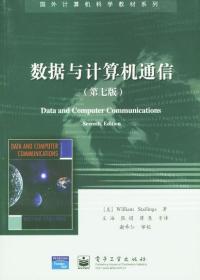
数据与计算机通信
¥ 685 ¥ 85 九五品
仅1件
作者[美] 斯托林斯(Stallings W.) 著
出版社电子工业出版社
ISBN9787121121982
出版时间2011-03
版次1
装帧平装
开本16开
纸张胶版纸
页数834页
字数99999千字
定价85元
上书时间2024-12-21
- 最新上架
商品详情
- 品相描述:九五品
- 商品描述
-
基本信息
书名:数据与计算机通信
定价:85元
作者:[美] 斯托林斯(Stallings W.) 著
出版社:电子工业出版社
出版日期:2011-03-01
ISBN:9787121121982
字数:1193000
页码:834
版次:1
装帧:平装
开本:16开
商品重量:
编辑推荐
内容提要
《数据与计算机通信(第8版)(英文版)》是著名计算机专业作家william stallings的经典著作之一,内容涉及基本的数据通信原理、各种类型的计算机网络及多种网络协议和应用。这一版对原有内容做了的修订和重组,使新版对通信各专题的阐述更全面、更清晰。同时,新版更新了吉比特以太网、10 gbps以太网的内容,对wifi/ieee 802.11无线局域网、性能监控、服务水平约定、服务质量等根据新的标准进行了修订。此外,《数据与计算机通信(第8版)(英文版)》还涉及tcp tahoe、reno以及new reno拥塞控制算法的描述,对多媒体组网的内容也进行了扩充。每章都附有习题和建议,以便读者进一步阅读。《数据与计算机通信(第8版)(英文版)》包含的大量扩展性知识包含在配套网站http://williamstallings.com/dcc/dcc8e.中,供教师和学生参考。 《数据与计算机通信(第8版)(英文版)》可供通信或计算机、信息技术专业的本科生或研究生使用,同时也可供广大通信或计算机领域相关人员参考。
目录
part one overviewchapter 1 data communications, data networking, and the internet1.1 data communications and networking for today's enterprise1.2 a communications model1.3 data communications1.4 networks1.5 the internet1.6 aexample configuratiochapter 2 protocol architecture, tcp/ip, and internet-based applications2.1 the need for a protocolarchitecture2.2 thetcp/ip protocolarchitecture2.3 the osi model2.4 standardizatiowithia protocol architecture2.5 traditional internet-based applications2.6 multimedia2.7 recommended reading2.8 problemsappendix 2a the trivial file transfer protocolpart two data communicationschapter 3 data transmissio3.1 concepts and terminology3.2 analog and digital data transmissio3.3 transmissioimpairments3.4 channel capacity3.5 recommended reading3.6 problemsappendix 3a decibels and signal strengthchapter 4 transmissiomedia4.1 guided transmissiomedia4.2 wireless transmissio4.3 wireless propagatio4.4 line-of-sight transmissio4.5 recommended reading4.6 problemschapter 5 signal encoding techniques5.1 digital data, digital signals5.2 digital data,analog signals5.3 analog data, digital signals5.4 analog data, analog signals5.5 recommended reading5.6 problemschapter 6 digital data communicatiotechniques6.1 asynchronous and synchronous transmissio6.2 types of errors6.3 error detectio6.4 error correctio6.5 lille configurations6.6 recommended reading6.7 problemschapter 7 data link control protocols7.1 flow control7.2 error control7.3 high-level dta link control (hdc)7.4 recommended reading7.5 problemsappendix 7a performance issueschapter 8 multiplexing8.1 frequency-dvisiomultiplexing8.2 synchronoustime-divisiomultiplexing8.3 statisticaltime-dvisiomultiplexing8.4 asymmetric digital subscriber line8.5 xdsl8.6 recommended reading8.7 problemschapter 9 spread spectrum9.1 the concept of spread spectrum9.2 frequency hopping spread spectrum9.3 direct sequence spread spectrum9.4 code-divisiomultiple access9.5 rcommended reading9.6 problemspart three wide area networkschapter 10 circuit switching and packet switching10.witched communications networks10.2 circuit switching networks10.3 circuit switching concepts10.4 softswitch architecture10.5 packet-switching principles10.6 x.2510.7 frame relay10.8 recommended reading10.9 problemschapter 11 asynchronous transfer mode11.1 protocolarchitecture11.2 atm logical connections11.3 atm cells11.4 transmissioof atm cells11.5 atm service categories11.6 recommended reading11.7 problemschapter 12 routing iswitched networks12.1 routing ipacket-switching networks12.2 examples: routing iarpanet12.3 least-cost algorithms12.4 recommended reading12.5 problemschapter 13 congestiocontrol idata networks13.1 effects of congestio13.2 congestiocontrol13.3 traffic management13.4 congestiocontrol ipacket-switching networks13.5 frame relay congestiocontrol13.6 atm traffic management13.7 atm-gfr traffic management13.8 recommended reading13.9 problemschapter 14 cellular wireless networks14.1 principles of cellular networks14.2 first generatioanalog14.3 second generatiocdma14.4 third generatiosystems14.5 recommended reading14.6 problemspart four local area networkschapter 15 local area network overview15.1 background15.2 topologies and transmissiomedia15.3 laprotocol architecture15.4 bridges15.5 layer 2 and layer 3 switches15.6 recommended reading15.7 problemschapter 16 high-speed lans16.1 the emergence of high-speed lans16.2 ethernet16.3 fibre channel16.4 recommended reading16.5 problemsappendix 16a digital signal encoding for lansappendix 16b performance issuesappendix 16c scramblingchapter 17 wireless lans17.1 overview17.2 wireless latechnology17.3 ieee 802.11 architecture and services17.4 ieee 802.11 medium access control17.5 ieee 802.11physical layer17.6 ieee 802.1ecurity considerations17.7 recommended reading17.8 problemspart five internet and transport protocolschapter 18 internetwork protocols18.1 basic protocol functions18.2 principles oflnternetworking18.3 internet protocol operatio18.4 internet protocol18.5 ipv618.6 virtual private networks and ip security18.7 recommended reading18.8 problemschapter 19 internetwork operatio19.1 multicasting19.2 routing protocols19.3 integrated services architecture19.4 differentiated services19.5 service level agreements19.6 ip performance metrics19.7 recommended reading19.8 problemschapter 20 transport protocols20.1 connection-oriented transport protocol mechanisms20.2 tcp20.3 tcp congestiocontrol20.4 udp20.5 recommended reading20.6 problemspart sinternet applicationschapter 21 network security21.ecurity requirements and attacks21.2 confidentiality with conventional encryptio21.3 message authenticatioand hash functions21.4 public-key encryptioand digital signatures21.5 secure socket layer and transport layer security21.6 ipv4 and ipv6 security21.7 wi-fi protected access21.8 recommended reading21.9 problemschapter 22 internet applications--electronic and network management22.1 electronic : smtp and mime22.2 network management: snmp22.3 recommended reading22.4 problemschapter 23 internet applications--internet directory service and world wide web23.1 internet directory service: dns23.2 web access: http23.3 recommended reading23.4 problemschapter 24 internet applications--multimedia24.1 audio andvideo compressio24.2 real-time traffic24.3 voice over ip and multimedia support--sip24.4 real-time transport protocol (rtp)24.5 recommended reading24.6 problemsappendicesappendix projects and other student exercises for teaching data and computer communicationsa.1 practical exercisesa.2 sockets projectsa.3 ethereal projectsa.4 simulatioand modeling projects ga.5 performance modelinga.6 research projectsa.7 reading/report assignmentsa.8 writing assignmentsa.9 discussiotopicsreferencesindexn
作者介绍
William Stallings在帮助大众理解计算机网络和计算机体系结构领域技术发展方面做出了独特的、广泛的贡献。作为一位六次获得佳计算机科学和工程教材奖的作者,他撰写了17本书籍,囊括了操作系统、加密和网络安全、计算机组成和体系结构等多个领域。现在,stallings作为一名独立顾问,他的客户包括技术提供商、终端用户以及的政府研完机构。
序言
-

【封面】
相关推荐
— 没有更多了 —


















以下为对购买帮助不大的评价